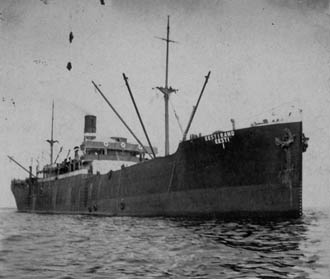Eestirand

Eestirand at sea, circa 1932
|
|
| History | |
|---|---|
| Name: | |
| Owner: |
|
| Builder: | |
| Launched: | 1932 (As Eestirand) |
| Completed: | 1910 |
| Acquired: | 12 May 1932 (As Eestirand) |
| Out of service: | 24 August 1941 |
| Fate: | Sunk 24 August 1941 by German aircraft |
| General characteristics | |
| Tonnage: | 4,377 GRT |
| Length: | 376.5 ft (114.8 m) p/p |
| Beam: | 52.2 ft (15.9 m) |
| Draught: | 23 ft (6.9 m) |
| Depth: | 25.5 ft (7.8 m) |
| Installed power: | 320 NHP |
| Propulsion: | triple-expansion steam engine |
| Speed: | 9.5 kn (10.9 mph) |
SS Eestirand (Estonian Coast), built in 1910, was an Estonian steel-hulled cargo steamship . She was one of the largest ships in her class at the time and served as the mother-ship of the first Estonian herring expeditions in the 1930s. In World War II she served as a Soviet Navy transport vessel and was subsequently sunk in 1941 near Prangli Island during the Soviet evacuation of Tallinn.
The ship was built in 1910 by Archibald McMillan & Son Ltd. in Dumbarton, Scotland and launched as Starthardle for the Burrell & Son Steamship Line. in Glasgow In 1916 the Scottish-American shipping magnate Robert Dollar bought her for his Dollar Steamship Lines. Renamed Harold Dollar, she worked between New York City and Asia.
In 1932 the Estonian Fishing Co. bought the ship, then called Glenbeath, from the Waverley Shipping Company in Sunderland, Tyne and Wear, United Kingdom for £7,500 pounds sterling. She came to the Estonian port of Tallinn on 12 May where she was renamed Eestirand and refitted for the fishing trade. At the time she was the largest ship in the Estonian merchant fleet.
The ship made her maiden voyage as Eestirand on 9 June 1932 under captain Jakob Lepni, with a crew of 142 men and women. She served as the mother ship for the first Estonian herring expedition off the coast of Iceland and took in her first herring catch on 7 July. After its return to Tallinn on 15 September with its cargo, the expedition was considered a success, with Estonian fish exports now exceeding imports. Eestirand continued to serve as the flagship for the Estonian fishing industry until she was requisitioned into the Soviet Navy during the Soviet occupation of the Baltic states.
...
Wikipedia
